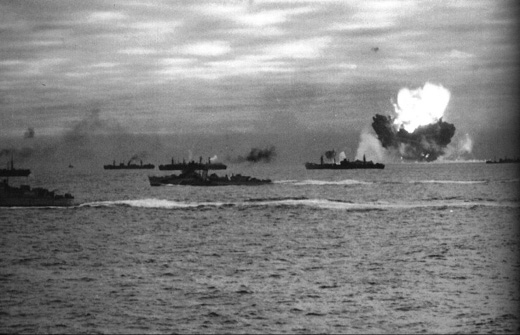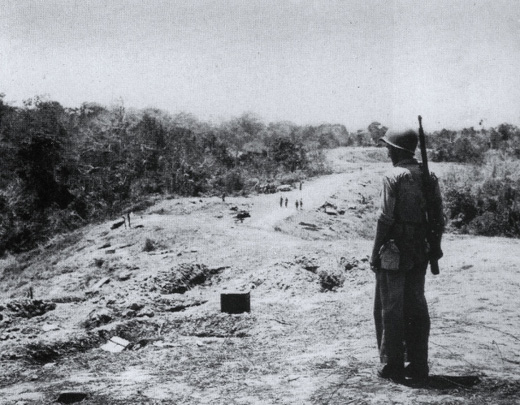Air Operations, Aleutians
13 28th Composite Bomb Group B-24s and 1 B-17, escorted by 14 XI Fighter Command P-38s and 14 P-39s, attack the Japanese submarine base at Kiska for the first time from the new USAAF airfield on Adak Island. 3 Japanese submarines are strafed, 2 minesweepers are sunk by bombs, and several ships and barges are damaged. In addition to strafing antiaircraft batteries and shore installations 54th Fighter Squadron P-38s and 42nd Fighter Squadron P-39s down 4 A6M2-N 'Rufe' float seaplanes and a biplane over Kiska. 2 P-38s and their pilots are lost in a mid-air collision.
[Air Operations, Europe
BOMBER COMMANDDaylight Ops:
- 5 Mosquitos bomb ports in northern Germany; Wilhelmshaven reports bombs falling in city center with 10 people injured; Kiel reports bombs falling in nearby village, but no particular damage; no losses.
- 22 aircraft of 5 types to Wilhelmshaven; Hampdens involved in the rain make last operational effort for front-line squadron.
- Pathfinder marking is accurate; Wilhelmshaven reports worst raid to date; housing and city center type buildings hardest hit; 77 people are killed and more than 50 injured.
- 2 Wellingtons are lost.
Aleutians
American bombers attack the Japanese held island of Kiska. The attacks are repeated during the next few days.
[ Explosion from Air Attack on Arctic Convoy PQ-18 |
 |
Air Operations, Greece
USAMEAF B-24s attack Axis ships in Suda Bay and are credited with setting a tanker on fire.
[Air Operations, Libya
USAMEAF heavy bombers attack Tobruk.
[Air Operations, New Guinea
1 3rd Light Bomb Group A-20 attacks ground targets at Myola.
[Air Operations, Solomons
- VF-5 F4Fs down 4 A6M2-N 'Rufe' float seaplanes over Guadalcanal about 1000 hours. 28 G4M 'Betty' bombers and an unknown number of escorting A6M Zeros attack Henderson Field about 1300 hours. 5 Marine Corps F4Fs down 2 'Bettys' and 2 Zeros about 1310 hours. Several Navy and Marine Coprs F4Fs shoot down 9 F1M 'Pete' float biplanes near Savo Island about 1745 hours.
- 11th Heavy Bomb Group B-17s attack Japanese warships in New Georgia Sound.
Arctic Ocean
U-589 has been shadowing Convoy PQ-18 when she is detected by a Swordfish aircraft of 825 NAS from the escort carrier HMS Avenger. The Swordfish attacks but is driven off by a Bv-138 reconnaissance aircraft. The destroyer HMS Onslow is dispatched to the area and sights the U-boat on the surface. Onslow makes her first attack at 1055 and continues for three hours after which it is determined that the U-boat has been destroyed.
| Class | Type VIIC |
| CO | Kapitänleutnant Hans Joachim Horrer |
| Location | Arctic, NW of North Cape |
| Cause | Air attack/depth charge |
| Casualties | 44 |
| Survivors | None |
Battle of the Atlantic
U-91 sinks the Canadian destroyer Ottawa in the Gulf of St Lawrence. 114 are lost, there are 67 survivors.
[Eastern Front
Von Paulus' infantry overcome desperate Russian resistance and penetrate into the center of Stalingrad, reaching the banks of the Volga. The Battle of Stalingrad approaches its epic climax.
SOUTHERN SECTORThe German assaults, backed up by massive artillery fire and Luftwaffe aircraft, continue. The XLVIII Panzer Corps takes the Tsaritsyn quarter while, south of Mamayev Kurgan, the 76th Infantry Div makes steady gains, taking the railway station (it changes hands four times during the day). Mamayev Kurgan falls to the 295th Infantry Div, cutting the 62nd Army in two. During the night the 13th Guards Rifle Div crosses the river and establishes a small bridgehead in the face of fierce resistance.
The Luftwaffe drops mines in the Volga River at Stalingrad.[MORE]
[Guadalcanal
The Japanese break off their attack on Bloody Ridge at dawn and withdraw under air attack, leaving about 600 dead of a force of an estimated 2,000. The Marine casualties on Bloody Ridge is about 20% of the force engaged: 31 killed, 103 wounded, and 9 missing. The exact composition of the Japanese forces is not clear. The 1st and 3rd Battalions, 124th Infantry, and the 2nd Battalion, 4th Infantry, probably deliver the assault against Bloody Ridge while the rear echelon of the Ichiki Force may have attacked the 1st Marines. The 2nd Battalion, 124th Infantry, probably delivered the weak attack against the 5th Marines.
The 2nd Battalion of the 5th Marines starts to relieve the provisional raider-parachute battalion. On the eastern flank along the Ilu River, the 3rd Battalion of the 1st Marines moves 6 light tanks against the enemy, but 3 are quickly disabled. The Japanese continue sporadic fire in this area. In the afternoon the Japanese attack the 3rd Battalion of the 5th Marines on the ridge commanding the coastal road to the western sector of the perimeter but are driven off. Vandegrift shifts the 3rd Bn, 2nd Marines, from Tulagi to Guadalcanal since that's where it appears the action will be.
At 0600 the 7th Marines sail for Guadalcanal aboard 6 transports escorted by all the cruisers and destroyers Ghormley would let go. South of Guadalcanal is the task force that supports the Wasp (CV-7) and the Hornet (CV-8) which are supplying air cover.
In the morning 4 Zero float planes come over to strafe the airfield area. All 4 shot are down by F4Fs. The noon bombing raid comes in with the usual results. Early in the afternoon another raid comes in with 25 Zeros escorting a handful of Bettys. The F4Fs get 1 Zero and 1 bomber. Just before dark, a dozen single-engine bombers hit Henderson Field again.
US Marine Stands Guard |
 |
During the day the destroyers Hill and Sterett (DD-407) escort 2 transports bring in supplies for the marines which are protected by Henderson aircraft during daylight. At dusk, however, seaplane fighters come in and strafe the ships. The Sterett's (DD-407) 5-inch gun brings down 1 plane. During the night the destroyers move across the channel to Tulagi Harbor. The Tokyo Express with 1 cruiser and 4 destroyers bombard Henderson Field, then speed back.
[Mediterranean
In Operations AGREEMENT, a raid on Tobruk, several ships are sunk. The British anti-aircraft ship Coventry is sunk by German bombing with the loss of 60 crewmen. The British destroyers Belvoir and Dulverton rescue the survivors and take them to Alexandria. The British destroyer Sikh is sunk by shore batteries at Tobruk with the loss of 21 of her crew. 253 survivors are made prisoners of war. The British destroyer Zulu is badly damaged by German bombing with the loss of 39 on board. The British destroyer Croome takes off all the survivors except for the towing party. The British destroyer Hursley takes the Zulu in tow, but she sinks later in the evening. Several coastal craft also take part in the operation. MTB-308, MTB-310 and MTB-312 are sunk by German bombing. MTB-352 and MTB-353 are sunk by gunfire from shore. A total of 43 men are lost in light craft.
[New Guinea
The Japanese have their final success on the Kokoda Trail when they move the Australians back to Imita Ridge, only about 30 miles from Port Moresby. Allied counterattacks, however, stop them from advancing any further. Port Moresby is receiving heavy reinforcements in the form of US infantry.
[